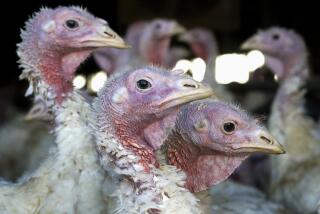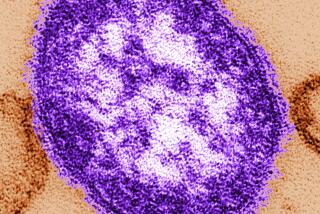California measles outbreak: 123 cases, latest is in Solano County
- Share via
The California-centered measles outbreak has spread to Solano County, as the number of cases rose to at least 123 in 11 California counties, seven other states and Mexico.
The California Department of Public Health reported Monday that there are now 107 cases in the state, with one case now confirmed in Solano County.
Of the 107 cases, at least 39 can be directly linked to visitors or employees at Disneyland during the holidays, 25 were family members or people who came in close contact with someone who had the measles, and at least five caught the measles by being in a public area such as an emergency room where a confirmed case was known to be present, officials said.
Database: Look up vaccination rates at California child-care centers
Cases connected to the California-centered outbreak have also been confirmed in at least seven other states: Arizona (five), Utah (three), Washington (two), Michigan (one), Oregon (one), Colorado (one) and Nebraska (one) -- as well as Mexico (two).
Eleven counties in California have confirmed measles cases: Alameda, Los Angeles, Marin, Orange, Riverside, San Bernardino, San Diego, San Mateo, Santa Clara, Solano and Ventura.
Orange County has 34 confirmed cases. Los Angeles County follows with 26 cases, San Diego County with 13 and Ventura with nine.
Nine of the California patients were infants less than 12 months old. About 60% of the cases were adults 20 years or older.
“For those individuals for whom we have vaccination status, the majority are unvaccinated,” state health officials said.
Of the cases in California, about one in five have had to be hospitalized, officials said.
Across the country, health officials have painstakingly traced the steps of measles patients, tried to identify anyone who came in contact with them, and quarantined those at greatest risk of getting the highly contagious disease to keep the virus from spreading.
In Santa Monica, 14 babies younger than a year old were under voluntary quarantine last week after an infant at the Samohi Infant/Toddler Center was diagnosed with measles.
Health officials said infants too young to be immunized are a particular concern and should avoid large crowds where international travelers are concentrated, such as theme parks and airports.
Federal recommendations call for the first dose of measles vaccination, known as MMR, to be given at 12 to 15 months of age, with a second between ages 4 and 6. California law requires two doses of the measles vaccination before kindergartners can enroll, but parents may obtain exemptions for the vaccines if they say the inoculations conflict with their personal beliefs.
Symptoms of measles include fever as high as 105 degrees Fahrenheit, cough, runny nose, redness of eyes, and a rash that begins at the head and spreads to the rest of the body. It can lead to inflammation of the brain, pneumonia and death.
Officials can take steps to protect unvaccinated people if their exposure to the measles virus is known. If caught within three days of exposure, a measles vaccine can provide protection from illness. Within six days of exposure, getting a substance called immunoglobulin -- concentrated antibodies extracted from donated blood that boost the immune system -- can also protect the patient, experts said.
Those who suspect that they have the measles are urged to first call their healthcare provider before going to a clinic, enabling caregivers to make special preparations so patients don’t risk infecting others in the waiting room.
In San Diego County, officials last month immediately shut down and disinfected an urgent care clinic after six measles patients arrived. About 160 people in contact with the patients were interviewed, and 20 were put under quarantine until they could prove they had immunity.
Have questions about measles? Read our FAQ and follow @RosannaXia for more news on the measles outbreak.
More to Read
Sign up for Essential California
The most important California stories and recommendations in your inbox every morning.
You may occasionally receive promotional content from the Los Angeles Times.











